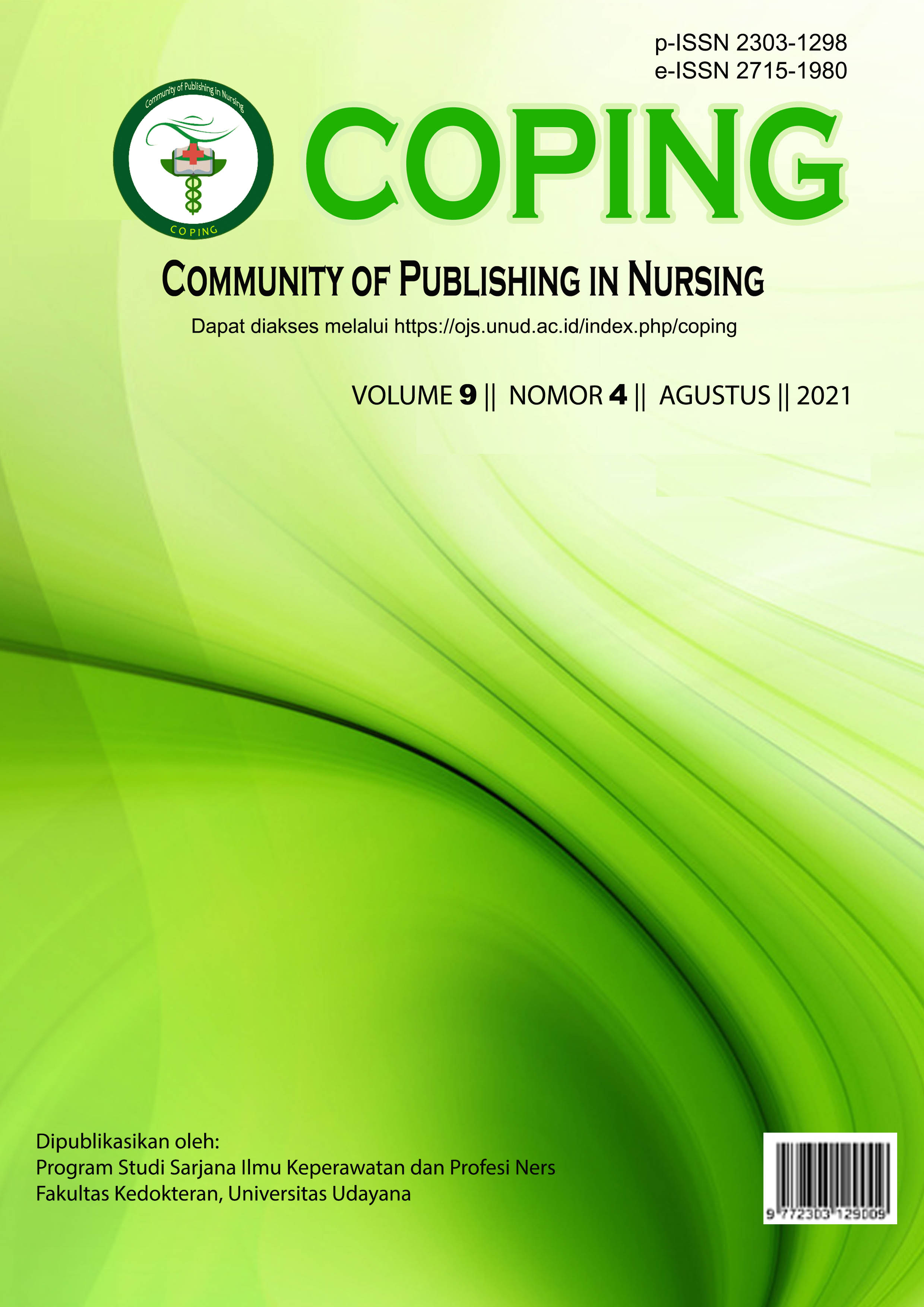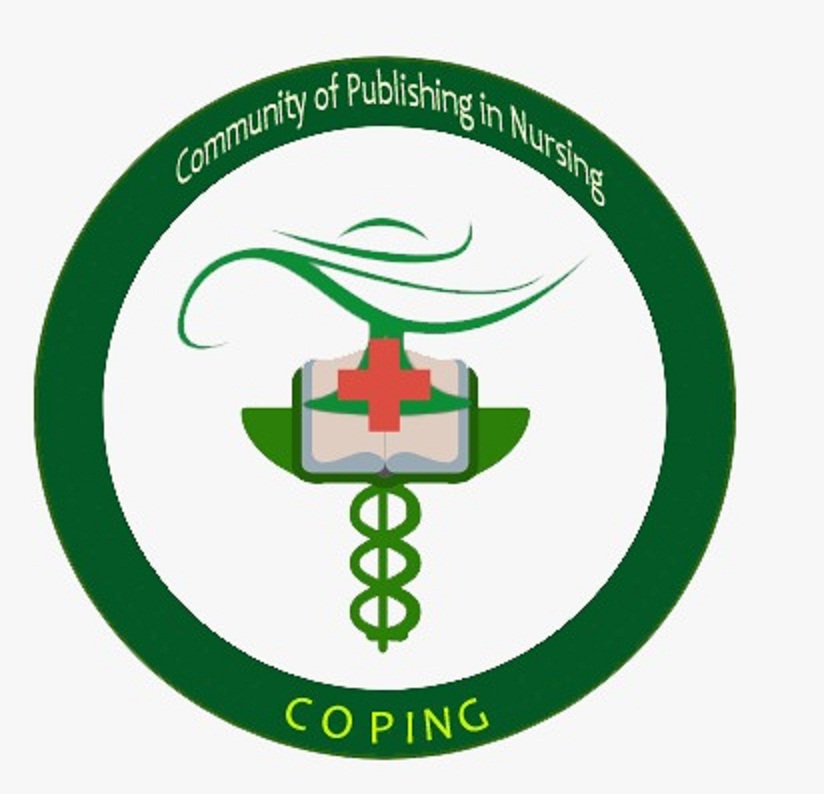PENGARUH PEMBELAJARAN TELENURSING TERHADAP PENGETAHUAN PENCEGAHAN KANKER SERVIKS PADA SISWI SMA NEGRI 1 SERIRIT
Abstract
Cervical cancer is an abnormal growth of cells in the cervix which is the second largest cause of death in women in the world. Introduction to cervical cancer is very necessary to avoid the effects that can occur. Telenursing can be used to disseminate information regarding cervical cancer prevention. The purpose of this study was to determine the effect of telenursing learning on the prevention of cervical cancer prevention in female students of Senior High Scool 1 Seririt. This type of research was a quasi experiment with one group pre-post test design. This research was conducted from 4th May to 18th May 2020 with a total of 45 samples. The research instrument used was a cervical cancer knowledge and cervical cancer prevention questionnaire, the results have been analyzed by Wilcoxon test. The results show that there are 34 people who have less knowledge before learning telenursing. After learning telenursing the level of knowledge of research subjects increased with 40 people with good knowledge. The average score of cervical cancer prevention knowledge respectively for pre-test 8.33 and post-test 16.31. Wilcoxon test results p-value 0,000 (p <0.05) which shows there is an effect of telenursing learning on increasing knowledge of cervical cancer prevention in female students of Senior High Scool 1 Seririt. Health workers can use telenursing as a medium to improve knowledge of cervical cancer in adolescents.
Downloads
References
Dinas Kesehatan Provinsi Bali. (2017). Profil Kesehatan Dinas Kesehatan Provinsi Bali. Denpasar.
Harahap, S. (2014). Analisis Pengetahuan dan Sikap Ibu Rumah Tangga Terhadap Pelaksanaan Pap Smear untuk Deteksi Kanker Serviks di Puskesmas Petisah Medan. Sumatera: USU.
Hayat, A., K., Huriati, Hidayah, N. (2017). Perbedaan Efektifitas Pendidikan Kesehatan Tatap Muka dengan Media Sosial terhadap Peningkatan Pengetahuan Keluarga dengan Skizofrenia. Journal of Islamic Nursing, 2(2), 11-19. https://doi.org/10.24252/join.v2i2.3976.
Javanmardifard, S., Ghodsbin, F., Kaviani, M. J., & Jahanbin, I. (2017). The Effect of Telenursing on Self-Efficacy in Patients with Non-Alcoholic Fatty Liver Disease: A Randomized Controlled Clinical trial. Gastroenterology and Hepatology From Bed to Bench, 10(4), 263–271.
Johnson, E.,B. (2012). CTL:Contextual Teaching and Learning. Bandung: Kaifa.
Kementerian Kesehatan Republik Indonesia. (2015). Buletin Kanker. Pusat Data dan Informasi Kementrian Kesehatan RI 2015.
Kementerian Kesehatan Republik Indonesia. (2016). Profil Kesehatan Indonesia. diakses dari: http://www.depkes.go.id/resources/download/pusdatin/profil-kesehatan-indonesia/Profil-Kesehatan-Indonesia-2016.pdf.
Mulyati, S. (2015). Pengaruh Media Film terhadap Sikap Ibu pada Deteksi Dini Kanker Serviks. Jurnal Kesehatan Masyarakat 11(1), 16-24.
Notoadmodjo, S. (2010). Promosi Kesehatan dan Ilmu Perilaku, cetakan kedua. Jakarta: Rineka Cipta.
Potter, P.,A., & Perry, A.,G. (2005). Buku Ajar: Fundamental Keperawatan, Konsep, Proses, dan Praktik (Edisi 4). Jakarta: EGC.
Rambe, Z. & Samosir, B., S. (2018). Penerapan Metode Pembelajaran Peringatan dan Pemberian Motivasi terhadap Peningkatan Minat Belajar Bidang Studi Ekonomi pada Materi Pokok Konsumsi, Tabungan dan Investasi Peserta Didik Kelas X Pon-Pes Muhammadiyah KHA Dahlan Sipirok Tahun Pelajaran 2016/2017. Nusantara (Jurnal Ilmu Pengetahuan Sosial) 4, 43-49.
Slameto. (2015). Belajar dan Faktor-faktor Yang Mempengaruhi. Jakarta: Rineka Cipta.
Wibisono, B., K. (2017). Efektivitas Penggunaan Grup Sosial Media Whatsapp sebagai Media Edukasi Penanganan Pertama Cedera Muskuloskeletal pada Pelatih Sepakbola. Skripsi, Universitas Negeri Yogyakarta. Diakses dari https://eprints.uny.ac.id/53575/
Wijayakusuma, H.,M.,H. (2008). Ramuan Lengkap Herbal Taklukan Penyakit. Jakarta: Pustaka Bunda
World Health Organization (WHO). (2012). Estimated cancer incidence, mortality, and prevalence word wide in 2012. diakses dari: https://publications.iarc.fr/Databases/Iarc-Cancerbases/GLOBOCAN-2012-Estimated-Cancer-Incidence-Mortality-And-Prevalence-Worldwide-In-2012-V1.0-2012
World Health Organization (WHO). (2016). Human Papillomavirus (HPV) And Cervical Cancer. Diakses dari: http://www. who.int/mediacentre/factsheets/fs380/en/.
Yuliawati Fitri. (2012). Penelitian Tindakan Kelas Untuk Pendidik Profesional. Yogyakarta: Pedagogia.







